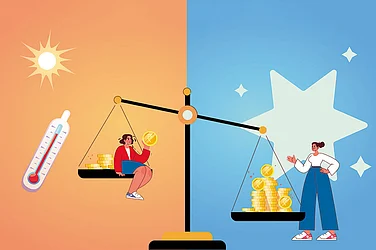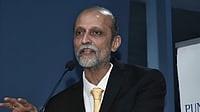Bringing down interest rates will not help India with private investments unless there is an increase in consumption and demand, says Devendra Kumar Pant, chief economist, India Ratings & Research.
In an interview with Outlook Business, he said, “It is not the interest rate which solely decides the investment. Ask any investor or manufacturer that had the repo rate been just 2 per cent today, would they have invested when there is no demand? Interest rate is a necessary but not a sufficient condition.”
Speaking at the launch of India Ratings’ macroeconomic outlook for the fiscal year 2024-25, Pant talked about why the rating agency has estimated India’s GDP growth rate at 6.5 per cent in the coming year, tepid private investments, inflation outlook, among other things. Edited Excerpts:
Q Both the government and the RBI have pegged GDP growth for FY25 at 7 per cent. Are you being cautious with your estimate of 6.5 per cent, or they are too optimistic?
One can look at it from two angles. There is a global economic landscape, and then there is domestic. Based on them, every analyst and institutions like RBI, among others, are making their assessment about the economy. Our reading currently leads us to an estimate of 6.5 per cent. I would not like to comment whether A is optimistic and B is pessimistic, but only our forecast.
This figure is built upon our forecast for FY24. Though first advance estimate is 7.3 per cent, our forecast for FY24 is still 6.9 per cent. However, the past numbers can be revised with the new data coming in with the National Statistical Office (NSO). And there is no harm in that. I do not look at that revision with a lot of suspicion. There are many numbers which are not available with the government and NSO has to make some assessment on that. As more and more data becomes available, they keep on updating their estimates. Based on this trend, our estimation for FY24 is 6.9 per cent and 6.5 per cent for FY25. If previous data changes, accordingly there will be changes in these estimates.
Q But still there has to be some explanation for this huge gap.
If you look at the present FY24 number, there is a huge term of discrepancy. It is not that there is some bungling with the numbers, because you have gross value addition from the production side, and then you have net taxes. You add these two, you get the GDP. And then you start allocating into different heads. When you are arriving at a number from two sides, where you have total on one side and distribution on other, it is impossible that these two numbers will match.
These are the income generated in the economy, which has to be allocated under different heads. But because there is no clarity about that number, there is discrepancy. When more data and clarity will come, this will start getting allocated. That allocation, wherever it sits, whichever head, will show a different growth trajectory. We could have done it, added say Rs 1 lakh crore this year for the discrepancy, for FY25. That would have given a larger GDP and higher growth. But since FY24’s discrepancy number is so huge, it is impossible for us to allocate and based on that take a growth trajectory. That is a major challenge.
Q Why is there a tussle of thoughts between the government and economists over the pick-up in private investments when it is something which should get established just by data itself?
Yes, there is a difference of opinion. Maybe the government has more access to information than all of us. They know who is approaching them for different approvals. When that fructifies and starts showing in the number, then we can have a similar opinion. There is no denial that investment is taking place. But it is not broad based. It is focused into certain sectors. When this will start going down to all sectors, then only you can term it as an investment revival. At present, consumption is not growing. That is what the government number shows. Capacity utilisation can be seen at somewhere around 75 to 76 per cent. When the demand is not strong, and I have one fourth of my capacities lying idle, why would I invest?
It is not the interest rate which solely decides the investment. Ask any investor or manufacturer that had the repo rate been just 2 per cent today, would they have invested when there is no demand? Interest rate is a necessary but not a sufficient condition. Those who sanction project loans will tell you that investments have been made even at a higher interest rate, because the demand was strong. Investments will only be made when there will be a revival in demand, and that 75 per cent capacity utilisation starts moving up.
Q Government claims to have inflation under control. But as per RBI, the impact of the rate-hike cycle is yet to be fully transmitted and the target remains to bring inflation below 4 per cent. Do you think there is any scope of a rate cut or change in stance by the central bank in the first half of the next fiscal year?
Our take is that no change in the monetary policy will happen before the second half. The difference between our numbers with the RBI is again due to assessment. We are looking at inflation in the third and fourth quarter on an upward trajectory. It is unlikely that it will give the monetary authority the confidence that inflation can be brought down to 4 per cent. And what will monetary easing or the rate cut will achieve when there is no demand? Investment is unlikely to kick-start, whether on durable basis or across the sector. Whatever happens on the monetary policy front, it will be purely data dependent.
Q How do you assess India’s potential in navigating the global challenges for its growth path?
India is and will always remain an internal demand story. Our share in world trade is insignificant. According to trade theory, we are a small country, at least on the goods side. On the services side, we are strong. We cannot go and create demand in other economies. What we can do is that we can have policies that are conducive for domestic demand. Unfortunately, what has happened in the past few years is that we are struggling with the domestic demand. The PFCE (Private Final Consumption Expenditure) growth has been relatively poor.
If you have the corporate profitability and demand, it will respond to your investment. If you have the real wages, you will see the response in PFCE. Consumption was seen contracting during high inflation regime, because the real wages of the people are not growing at the same pace as that of inflation. In the agriculture sector, real wages are in the negative territory. And the response of real wages to consumption is so strong that 1 per cent point increase in real wages will lead to a 112 basis point increase in the consumption growth, which in turn will lead to a 64 basis point increase in the GDP growth. You can achieve 1 per cent point higher real wages just by bringing down inflation by 1 per cent point. That is why inflation is and will always remain the biggest risk for any economy.
Q How do you think the government can bridge the gap between urban and rural demand as it has only widened in the recent years?
This is the biggest challenge. Even when more than 80 crore people are getting free food grain, consumption is not picking up. This shows that there is stress in the system. Government has introduced Bharat Atta and Bharat Dal, which means that there is a stress on people other than those bottom 80 crore. Only recently we have seen the MGNREGA demand slowing down. It is unlikely that the rural demand will pick-up unless this stress goes away. Again going back, inflation is the biggest risk.
Q Speaking more of corporate investments, progress in PLI (Production-Linked Incentive) scheme has not been uniform across sectors. Why is that?
This also leads to the consumption and demand story. The biggest success of PLI has been in electronics. Those who have stable income are buying high-end smart phones and they are not under stress. Whether these phones are made in India or Taiwan, they would remain neutral to it as long as the quality is same. Those 80 crore people who need intervention in form of free ration are not in the position to buy higher-end phones. They will always be dependent on the lower-end mobiles. So the demand for these upper-end smart phones is not impacted and the scheme is successful there. You will find problems where you are producing something for mass consumption.
Q An argument has emerged that IIP has lost its seriousness as a macroeconomic indicator and in some way become irrelevant. What are your thoughts?
IIP alone will not tell you what is happening in the economy because of many things. Manufacturing is roughly around 12 to 13 per cent of the total economy and IIP only concerns the corporate manufacturing. It tells you only a limited thing. But yes, there are certain things for example, capital goods. I do not think that much of capital goods are produced in the non-corporate world. Almost entire cement is produced in the corporate world.
Saying that it is irrelevant is incorrect, and calling it as the indicator is also incorrect. IIP has to be looked along with other indicators, because people all over the world are running after PMI, which has very limited responses. It talks about data in relation to the previous month. Suppose previous month was worse and from there you are expecting 5 per cent or 10 per cent better that may translate to a different story altogether, whereas IIP simply talks year-on-year. Any indicator will have its plus and minus.



























